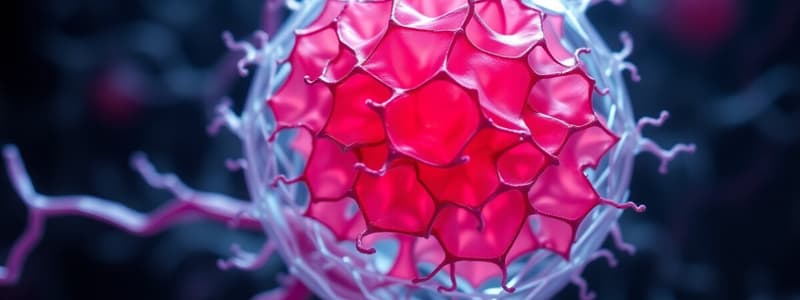Podcast
Questions and Answers
What is the primary function of the Golgi apparatus?
What is the primary function of the Golgi apparatus?
- Photosynthesis
- Muscle contraction
- Packaging and sorting of molecules (correct)
- Lipid synthesis
Which type of endoplasmic reticulum is involved in the synthesis of carbohydrates and lipids?
Which type of endoplasmic reticulum is involved in the synthesis of carbohydrates and lipids?
- Rough ER
- Golgi apparatus
- Central Vacuole
- Smooth ER (correct)
What is one of the key functions of lysosomes?
What is one of the key functions of lysosomes?
- Breakdown of waste materials (correct)
- Ribosome assembly
- Energy production
- Photosynthesis
What do peroxisomes produce when they break down fatty acids?
What do peroxisomes produce when they break down fatty acids?
Which structure is primarily responsible for ATP synthesis in animal cells?
Which structure is primarily responsible for ATP synthesis in animal cells?
What is a defining characteristic of prokaryotic cells?
What is a defining characteristic of prokaryotic cells?
Which of the following is true regarding the endomembrane system?
Which of the following is true regarding the endomembrane system?
What is the primary structural difference between Archaea and Bacteria?
What is the primary structural difference between Archaea and Bacteria?
Which component is NOT part of eukaryotic cells?
Which component is NOT part of eukaryotic cells?
What is the role of the nucleolus within a eukaryotic cell?
What is the role of the nucleolus within a eukaryotic cell?
Which structure serves as the semi-permeable barrier surrounding eukaryotic cells?
Which structure serves as the semi-permeable barrier surrounding eukaryotic cells?
What type of microscopy uses electron beams to achieve higher resolution?
What type of microscopy uses electron beams to achieve higher resolution?
Which of the following is a function of the cytoskeleton?
Which of the following is a function of the cytoskeleton?
Flashcards are hidden until you start studying
Study Notes
Cell Structure and Organelles
-
Nucleus: Largest structure in the cell, responsible for ribosome assembly.
-
Endoplasmic Reticulum (ER):
- Composed of lipids and tubule proteins; continuous with the nuclear envelope.
- Lumen: Interior space of the ER.
- Rough ER: Studded with ribosomes; synthesizes proteins that enter the lumen for transport via vesicles.
- Smooth ER: Lacks ribosomes; synthesizes carbohydrates and lipids, and stores calcium ions.
-
Vesicles and Vacuoles:
- Membrane-bound sacs for transport and storage.
- Vacuoles are generally larger than vesicles.
-
Golgi Apparatus:
- Responsible for packaging, sorting, and tagging molecules for various destinations.
-
Lysosomes:
- Function as cellular "garbage disposals"; break down proteins, lipids, and carbohydrates and recycle molecules.
- Operate at low pH.
-
Ribosomes:
- Sites of protein synthesis, either bound to the ER or free in the cytoplasm of prokaryotic cells.
-
Peroxisomes:
- Breakdown factories for lipids and amino acids; produce H2O2 as a byproduct, which is neutralized before leaving.
Cellular Energy Factories
-
Mitochondria:
- Sites of ATP synthesis, carbohydrate, and lipid metabolism.
- Feature two bilayer membranes with folds called cristae; contain their own DNA.
-
Chloroplasts:
- Present in plant cells; function in photosynthesis.
- Comprise two membranes and contain thylakoids, stacked into granum within the stroma.
Other Plant-Specific Structures
-
Central Vacuole:
- Regulates water levels within plant cells.
-
Cell Wall:
- Composed of cellulose, providing rigidity and support.
Cell Theory
- All living organisms consist of one or more cells, proposed historically by Robert Hooke, Anton von Leeuwenhoek, Schleiden, and Schwann.
Microscopy
-
Light Microscopes:
- Resolution of about 250 eukaryotic cells with a 2mm pin diameter.
-
Electron Microscopes:
- Utilize electron beams with a resolution of 2μm.
Prokaryotic Cells
- Single-celled organisms without membrane-bound organelles; include structures like:
- Cell Membrane: Phospholipid bilayer.
- Cell Wall & Capsule: Composed of peptidoglycan; penicillin affects this structure.
- Pili: Function in conjunction (conjugation).
Three Domains of Life
- Bacteria, Archaea, and Eukarya.
- Key differences: Archaea lack peptidoglycan in cell walls and have different membrane phospholipids compared to bacteria.
Eukaryotic Cells
- Contain membrane-bound organelles and a nucleus; significantly larger than prokaryotic cells.
Eukaryotic Cell Structures
- Plasma Membrane: Composed of phospholipids and proteins, separates the outside environment from the cytoplasm.
- Cytosol: Liquid component of the cytoplasm, around 70% water.
Cytoskeleton
- A network of protein fibers maintaining cell shape, consisting of microfilaments, intermediate filaments, and microtubules.
Endomembrane System
- A system of membrane-bound compartments managing lipid and protein transport, including the nuclear envelope, lysosomes, vesicles, ER, and Golgi apparatus.
Nucleus
- Contains all cellular DNA packaged into chromosomes; features a nuclear envelope and nucleolus for ribosome production.
Studying That Suits You
Use AI to generate personalized quizzes and flashcards to suit your learning preferences.




